Report: Develop and Maintain a Service Level Strategy - BSBCUE604
VerifiedAdded on 2022/11/13
|8
|1737
|498
Report
AI Summary
This report comprehensively addresses the development and maintenance of a service level strategy, covering various aspects such as contact-wait characteristics, service level data collection, and historical data analysis. It explores the differences between contact-wait characteristics and service level data, detailing the collection of relevant and accurate data including contact-wait time, abandonment rates, and customer survey data. The report emphasizes the importance of formulating a service level policy, consulting with stakeholders, and identifying business needs. It also delves into industry standards, benchmarking, contingency planning, and resource identification, alongside the monitoring of service levels through diagnostic measures and analysis of underperforming periods. The report highlights the benefits of benchmarking and provides insights into the elements that should be included within service level plans. The content presented is sourced from a student's assignment and available on the Desklib platform.
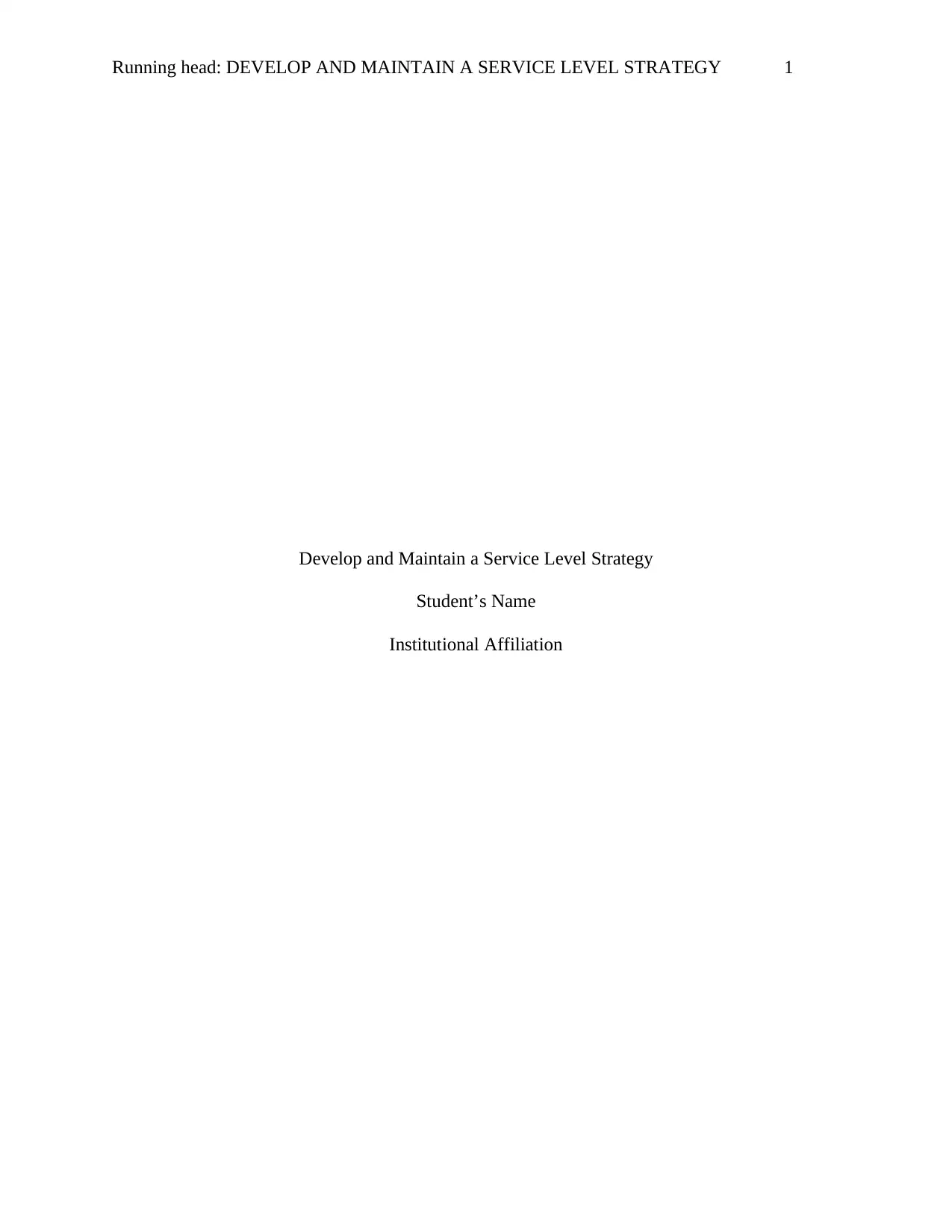
Running head: DEVELOP AND MAINTAIN A SERVICE LEVEL STRATEGY 1
Develop and Maintain a Service Level Strategy
Student’s Name
Institutional Affiliation
Develop and Maintain a Service Level Strategy
Student’s Name
Institutional Affiliation
Paraphrase This Document
Need a fresh take? Get an instant paraphrase of this document with our AI Paraphraser
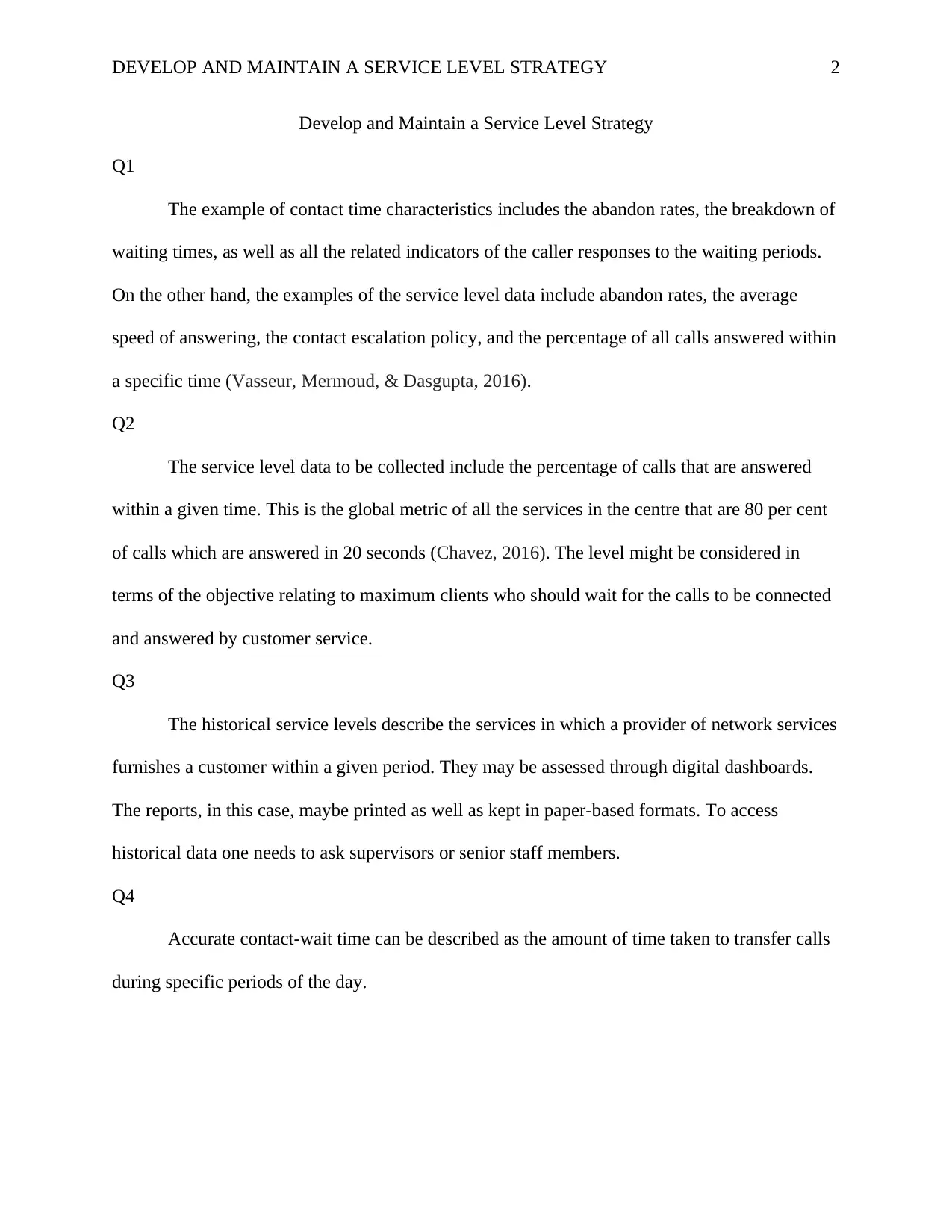
DEVELOP AND MAINTAIN A SERVICE LEVEL STRATEGY 2
Develop and Maintain a Service Level Strategy
Q1
The example of contact time characteristics includes the abandon rates, the breakdown of
waiting times, as well as all the related indicators of the caller responses to the waiting periods.
On the other hand, the examples of the service level data include abandon rates, the average
speed of answering, the contact escalation policy, and the percentage of all calls answered within
a specific time (Vasseur, Mermoud, & Dasgupta, 2016).
Q2
The service level data to be collected include the percentage of calls that are answered
within a given time. This is the global metric of all the services in the centre that are 80 per cent
of calls which are answered in 20 seconds (Chavez, 2016). The level might be considered in
terms of the objective relating to maximum clients who should wait for the calls to be connected
and answered by customer service.
Q3
The historical service levels describe the services in which a provider of network services
furnishes a customer within a given period. They may be assessed through digital dashboards.
The reports, in this case, maybe printed as well as kept in paper-based formats. To access
historical data one needs to ask supervisors or senior staff members.
Q4
Accurate contact-wait time can be described as the amount of time taken to transfer calls
during specific periods of the day.
Develop and Maintain a Service Level Strategy
Q1
The example of contact time characteristics includes the abandon rates, the breakdown of
waiting times, as well as all the related indicators of the caller responses to the waiting periods.
On the other hand, the examples of the service level data include abandon rates, the average
speed of answering, the contact escalation policy, and the percentage of all calls answered within
a specific time (Vasseur, Mermoud, & Dasgupta, 2016).
Q2
The service level data to be collected include the percentage of calls that are answered
within a given time. This is the global metric of all the services in the centre that are 80 per cent
of calls which are answered in 20 seconds (Chavez, 2016). The level might be considered in
terms of the objective relating to maximum clients who should wait for the calls to be connected
and answered by customer service.
Q3
The historical service levels describe the services in which a provider of network services
furnishes a customer within a given period. They may be assessed through digital dashboards.
The reports, in this case, maybe printed as well as kept in paper-based formats. To access
historical data one needs to ask supervisors or senior staff members.
Q4
Accurate contact-wait time can be described as the amount of time taken to transfer calls
during specific periods of the day.
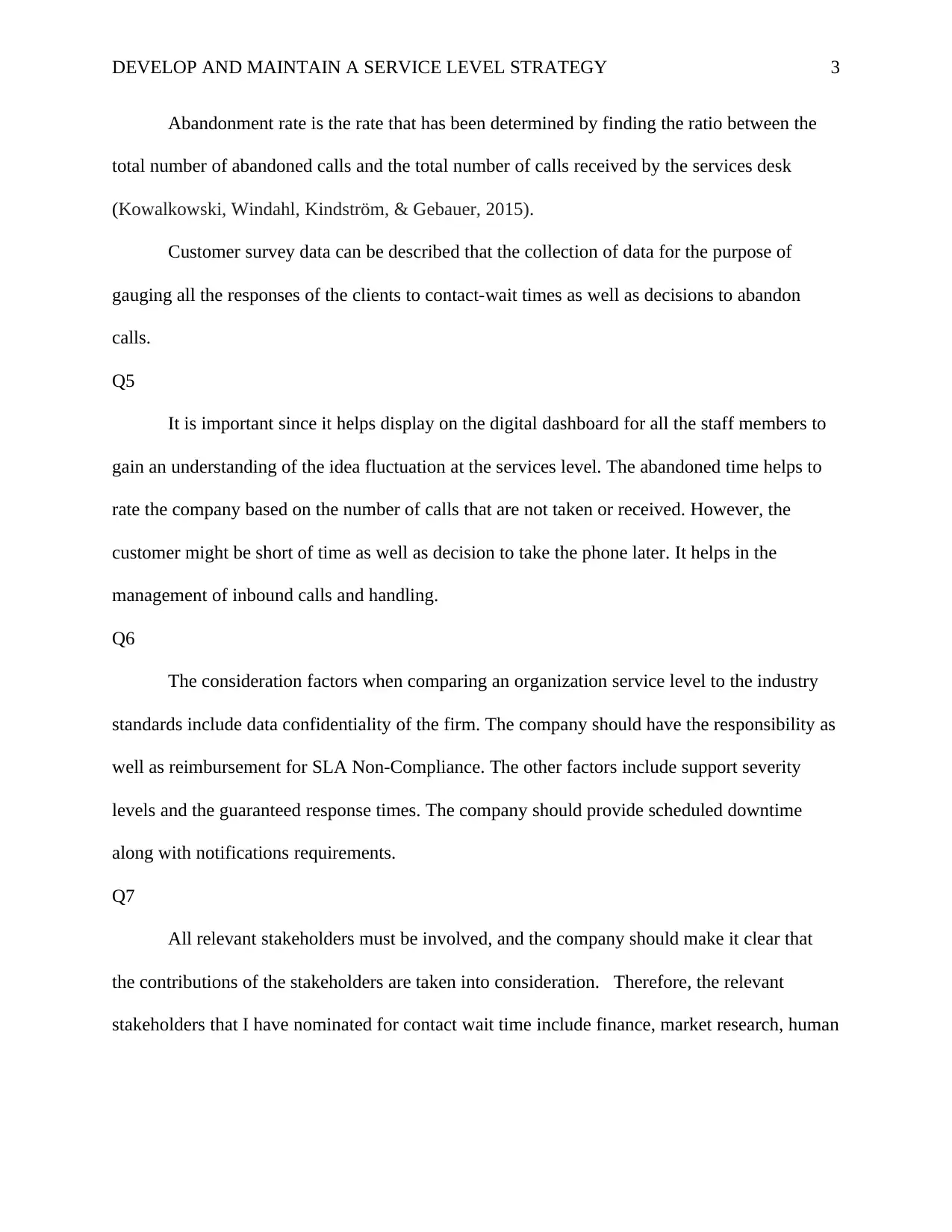
DEVELOP AND MAINTAIN A SERVICE LEVEL STRATEGY 3
Abandonment rate is the rate that has been determined by finding the ratio between the
total number of abandoned calls and the total number of calls received by the services desk
(Kowalkowski, Windahl, Kindström, & Gebauer, 2015).
Customer survey data can be described that the collection of data for the purpose of
gauging all the responses of the clients to contact-wait times as well as decisions to abandon
calls.
Q5
It is important since it helps display on the digital dashboard for all the staff members to
gain an understanding of the idea fluctuation at the services level. The abandoned time helps to
rate the company based on the number of calls that are not taken or received. However, the
customer might be short of time as well as decision to take the phone later. It helps in the
management of inbound calls and handling.
Q6
The consideration factors when comparing an organization service level to the industry
standards include data confidentiality of the firm. The company should have the responsibility as
well as reimbursement for SLA Non-Compliance. The other factors include support severity
levels and the guaranteed response times. The company should provide scheduled downtime
along with notifications requirements.
Q7
All relevant stakeholders must be involved, and the company should make it clear that
the contributions of the stakeholders are taken into consideration. Therefore, the relevant
stakeholders that I have nominated for contact wait time include finance, market research, human
Abandonment rate is the rate that has been determined by finding the ratio between the
total number of abandoned calls and the total number of calls received by the services desk
(Kowalkowski, Windahl, Kindström, & Gebauer, 2015).
Customer survey data can be described that the collection of data for the purpose of
gauging all the responses of the clients to contact-wait times as well as decisions to abandon
calls.
Q5
It is important since it helps display on the digital dashboard for all the staff members to
gain an understanding of the idea fluctuation at the services level. The abandoned time helps to
rate the company based on the number of calls that are not taken or received. However, the
customer might be short of time as well as decision to take the phone later. It helps in the
management of inbound calls and handling.
Q6
The consideration factors when comparing an organization service level to the industry
standards include data confidentiality of the firm. The company should have the responsibility as
well as reimbursement for SLA Non-Compliance. The other factors include support severity
levels and the guaranteed response times. The company should provide scheduled downtime
along with notifications requirements.
Q7
All relevant stakeholders must be involved, and the company should make it clear that
the contributions of the stakeholders are taken into consideration. Therefore, the relevant
stakeholders that I have nominated for contact wait time include finance, market research, human
⊘ This is a preview!⊘
Do you want full access?
Subscribe today to unlock all pages.

Trusted by 1+ million students worldwide
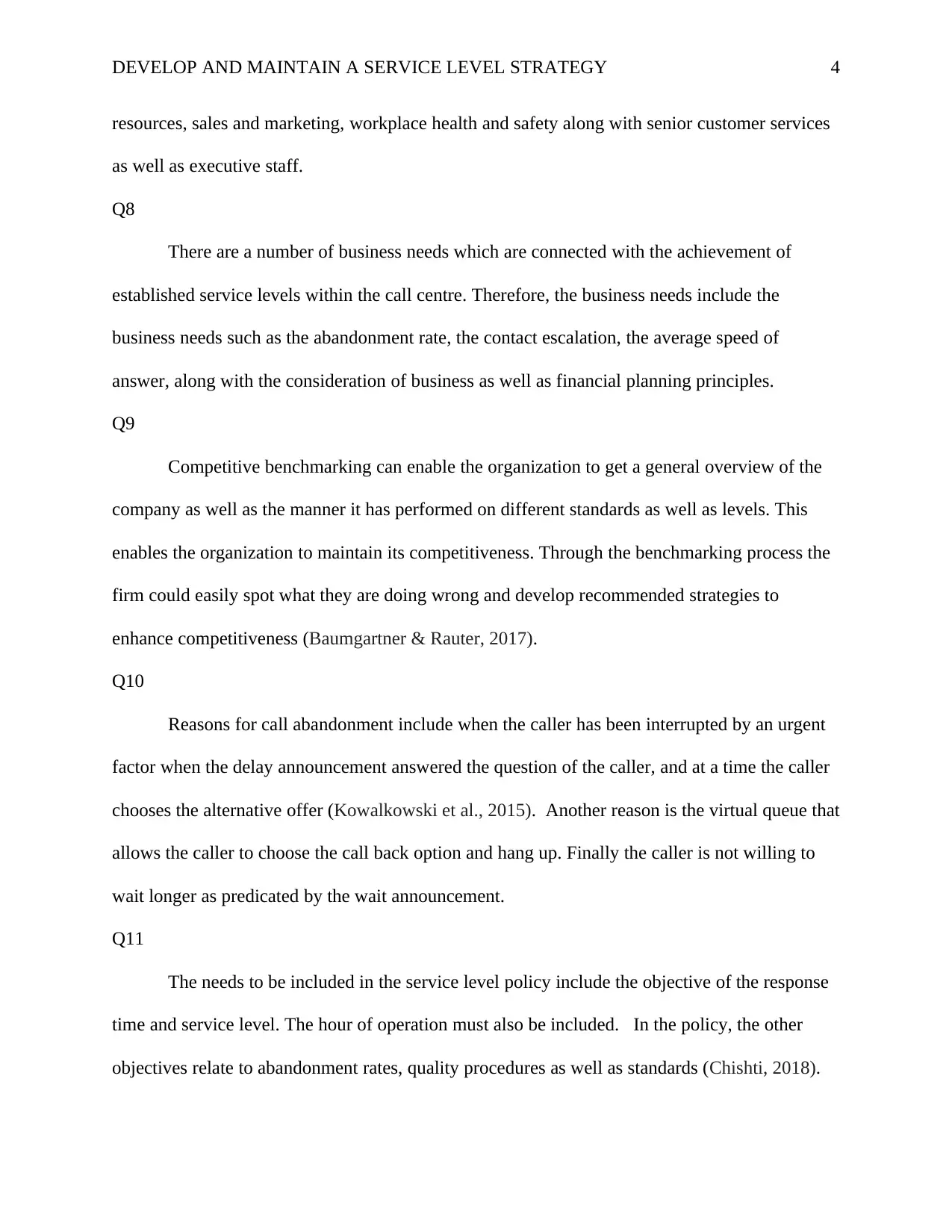
DEVELOP AND MAINTAIN A SERVICE LEVEL STRATEGY 4
resources, sales and marketing, workplace health and safety along with senior customer services
as well as executive staff.
Q8
There are a number of business needs which are connected with the achievement of
established service levels within the call centre. Therefore, the business needs include the
business needs such as the abandonment rate, the contact escalation, the average speed of
answer, along with the consideration of business as well as financial planning principles.
Q9
Competitive benchmarking can enable the organization to get a general overview of the
company as well as the manner it has performed on different standards as well as levels. This
enables the organization to maintain its competitiveness. Through the benchmarking process the
firm could easily spot what they are doing wrong and develop recommended strategies to
enhance competitiveness (Baumgartner & Rauter, 2017).
Q10
Reasons for call abandonment include when the caller has been interrupted by an urgent
factor when the delay announcement answered the question of the caller, and at a time the caller
chooses the alternative offer (Kowalkowski et al., 2015). Another reason is the virtual queue that
allows the caller to choose the call back option and hang up. Finally the caller is not willing to
wait longer as predicated by the wait announcement.
Q11
The needs to be included in the service level policy include the objective of the response
time and service level. The hour of operation must also be included. In the policy, the other
objectives relate to abandonment rates, quality procedures as well as standards (Chishti, 2018).
resources, sales and marketing, workplace health and safety along with senior customer services
as well as executive staff.
Q8
There are a number of business needs which are connected with the achievement of
established service levels within the call centre. Therefore, the business needs include the
business needs such as the abandonment rate, the contact escalation, the average speed of
answer, along with the consideration of business as well as financial planning principles.
Q9
Competitive benchmarking can enable the organization to get a general overview of the
company as well as the manner it has performed on different standards as well as levels. This
enables the organization to maintain its competitiveness. Through the benchmarking process the
firm could easily spot what they are doing wrong and develop recommended strategies to
enhance competitiveness (Baumgartner & Rauter, 2017).
Q10
Reasons for call abandonment include when the caller has been interrupted by an urgent
factor when the delay announcement answered the question of the caller, and at a time the caller
chooses the alternative offer (Kowalkowski et al., 2015). Another reason is the virtual queue that
allows the caller to choose the call back option and hang up. Finally the caller is not willing to
wait longer as predicated by the wait announcement.
Q11
The needs to be included in the service level policy include the objective of the response
time and service level. The hour of operation must also be included. In the policy, the other
objectives relate to abandonment rates, quality procedures as well as standards (Chishti, 2018).
Paraphrase This Document
Need a fresh take? Get an instant paraphrase of this document with our AI Paraphraser
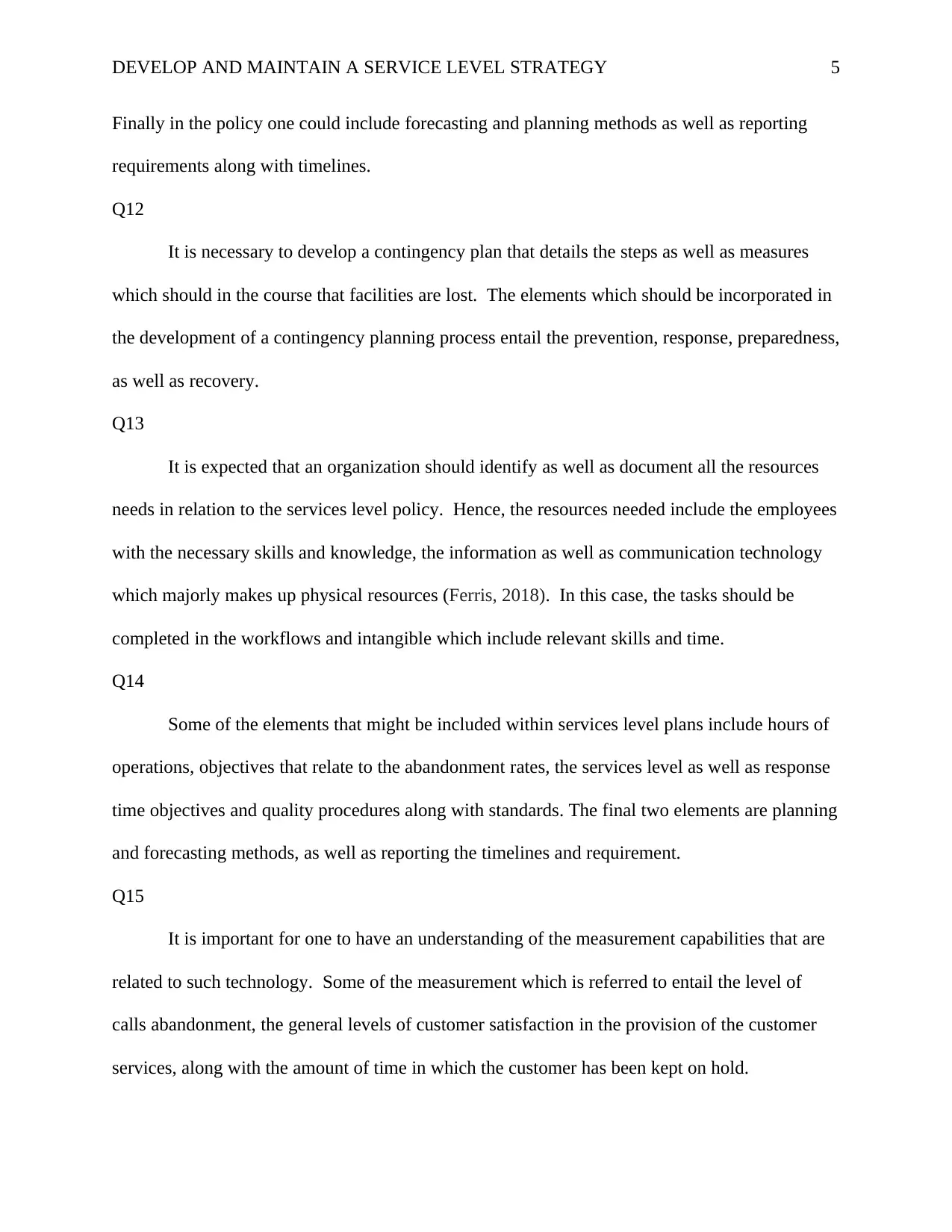
DEVELOP AND MAINTAIN A SERVICE LEVEL STRATEGY 5
Finally in the policy one could include forecasting and planning methods as well as reporting
requirements along with timelines.
Q12
It is necessary to develop a contingency plan that details the steps as well as measures
which should in the course that facilities are lost. The elements which should be incorporated in
the development of a contingency planning process entail the prevention, response, preparedness,
as well as recovery.
Q13
It is expected that an organization should identify as well as document all the resources
needs in relation to the services level policy. Hence, the resources needed include the employees
with the necessary skills and knowledge, the information as well as communication technology
which majorly makes up physical resources (Ferris, 2018). In this case, the tasks should be
completed in the workflows and intangible which include relevant skills and time.
Q14
Some of the elements that might be included within services level plans include hours of
operations, objectives that relate to the abandonment rates, the services level as well as response
time objectives and quality procedures along with standards. The final two elements are planning
and forecasting methods, as well as reporting the timelines and requirement.
Q15
It is important for one to have an understanding of the measurement capabilities that are
related to such technology. Some of the measurement which is referred to entail the level of
calls abandonment, the general levels of customer satisfaction in the provision of the customer
services, along with the amount of time in which the customer has been kept on hold.
Finally in the policy one could include forecasting and planning methods as well as reporting
requirements along with timelines.
Q12
It is necessary to develop a contingency plan that details the steps as well as measures
which should in the course that facilities are lost. The elements which should be incorporated in
the development of a contingency planning process entail the prevention, response, preparedness,
as well as recovery.
Q13
It is expected that an organization should identify as well as document all the resources
needs in relation to the services level policy. Hence, the resources needed include the employees
with the necessary skills and knowledge, the information as well as communication technology
which majorly makes up physical resources (Ferris, 2018). In this case, the tasks should be
completed in the workflows and intangible which include relevant skills and time.
Q14
Some of the elements that might be included within services level plans include hours of
operations, objectives that relate to the abandonment rates, the services level as well as response
time objectives and quality procedures along with standards. The final two elements are planning
and forecasting methods, as well as reporting the timelines and requirement.
Q15
It is important for one to have an understanding of the measurement capabilities that are
related to such technology. Some of the measurement which is referred to entail the level of
calls abandonment, the general levels of customer satisfaction in the provision of the customer
services, along with the amount of time in which the customer has been kept on hold.
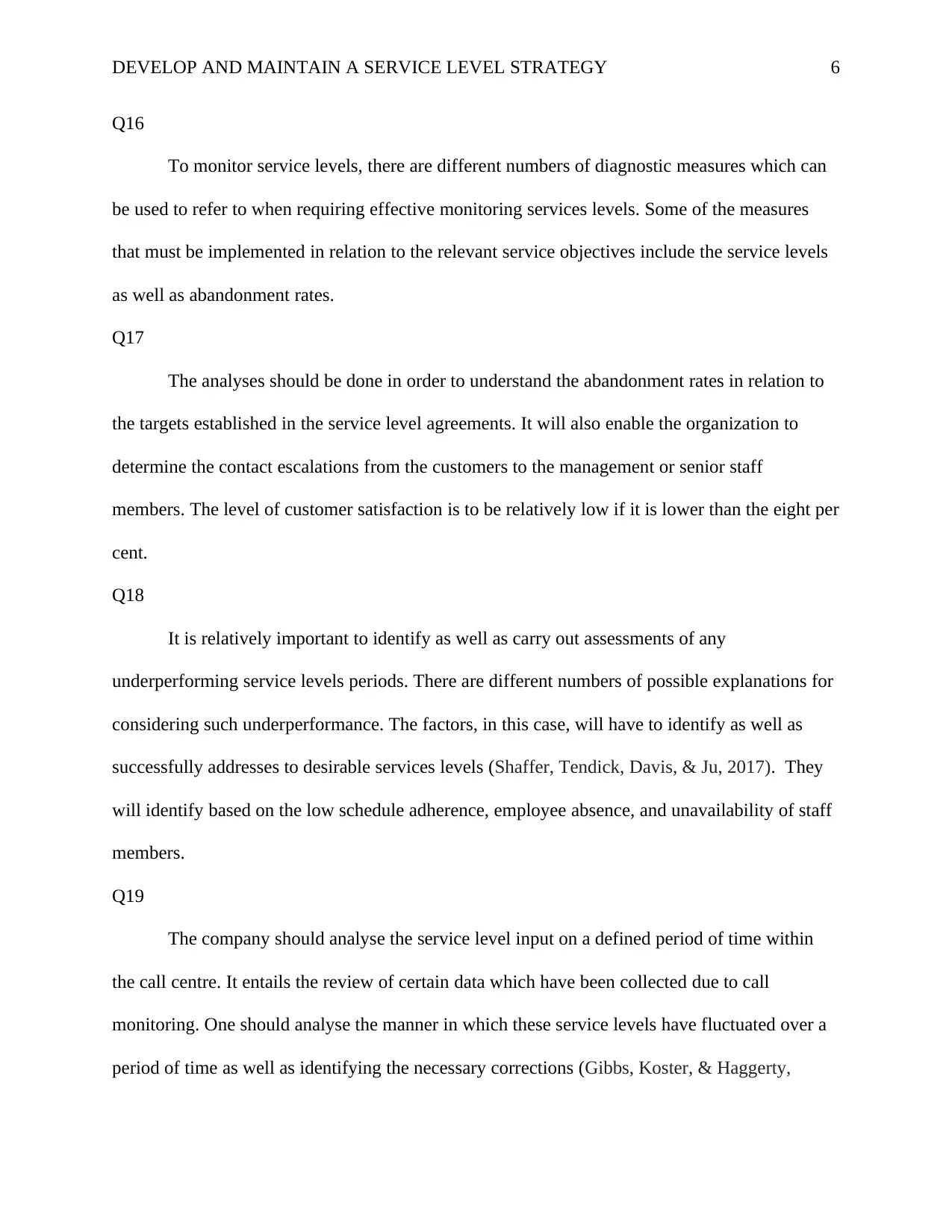
DEVELOP AND MAINTAIN A SERVICE LEVEL STRATEGY 6
Q16
To monitor service levels, there are different numbers of diagnostic measures which can
be used to refer to when requiring effective monitoring services levels. Some of the measures
that must be implemented in relation to the relevant service objectives include the service levels
as well as abandonment rates.
Q17
The analyses should be done in order to understand the abandonment rates in relation to
the targets established in the service level agreements. It will also enable the organization to
determine the contact escalations from the customers to the management or senior staff
members. The level of customer satisfaction is to be relatively low if it is lower than the eight per
cent.
Q18
It is relatively important to identify as well as carry out assessments of any
underperforming service levels periods. There are different numbers of possible explanations for
considering such underperformance. The factors, in this case, will have to identify as well as
successfully addresses to desirable services levels (Shaffer, Tendick, Davis, & Ju, 2017). They
will identify based on the low schedule adherence, employee absence, and unavailability of staff
members.
Q19
The company should analyse the service level input on a defined period of time within
the call centre. It entails the review of certain data which have been collected due to call
monitoring. One should analyse the manner in which these service levels have fluctuated over a
period of time as well as identifying the necessary corrections (Gibbs, Koster, & Haggerty,
Q16
To monitor service levels, there are different numbers of diagnostic measures which can
be used to refer to when requiring effective monitoring services levels. Some of the measures
that must be implemented in relation to the relevant service objectives include the service levels
as well as abandonment rates.
Q17
The analyses should be done in order to understand the abandonment rates in relation to
the targets established in the service level agreements. It will also enable the organization to
determine the contact escalations from the customers to the management or senior staff
members. The level of customer satisfaction is to be relatively low if it is lower than the eight per
cent.
Q18
It is relatively important to identify as well as carry out assessments of any
underperforming service levels periods. There are different numbers of possible explanations for
considering such underperformance. The factors, in this case, will have to identify as well as
successfully addresses to desirable services levels (Shaffer, Tendick, Davis, & Ju, 2017). They
will identify based on the low schedule adherence, employee absence, and unavailability of staff
members.
Q19
The company should analyse the service level input on a defined period of time within
the call centre. It entails the review of certain data which have been collected due to call
monitoring. One should analyse the manner in which these service levels have fluctuated over a
period of time as well as identifying the necessary corrections (Gibbs, Koster, & Haggerty,
⊘ This is a preview!⊘
Do you want full access?
Subscribe today to unlock all pages.

Trusted by 1+ million students worldwide
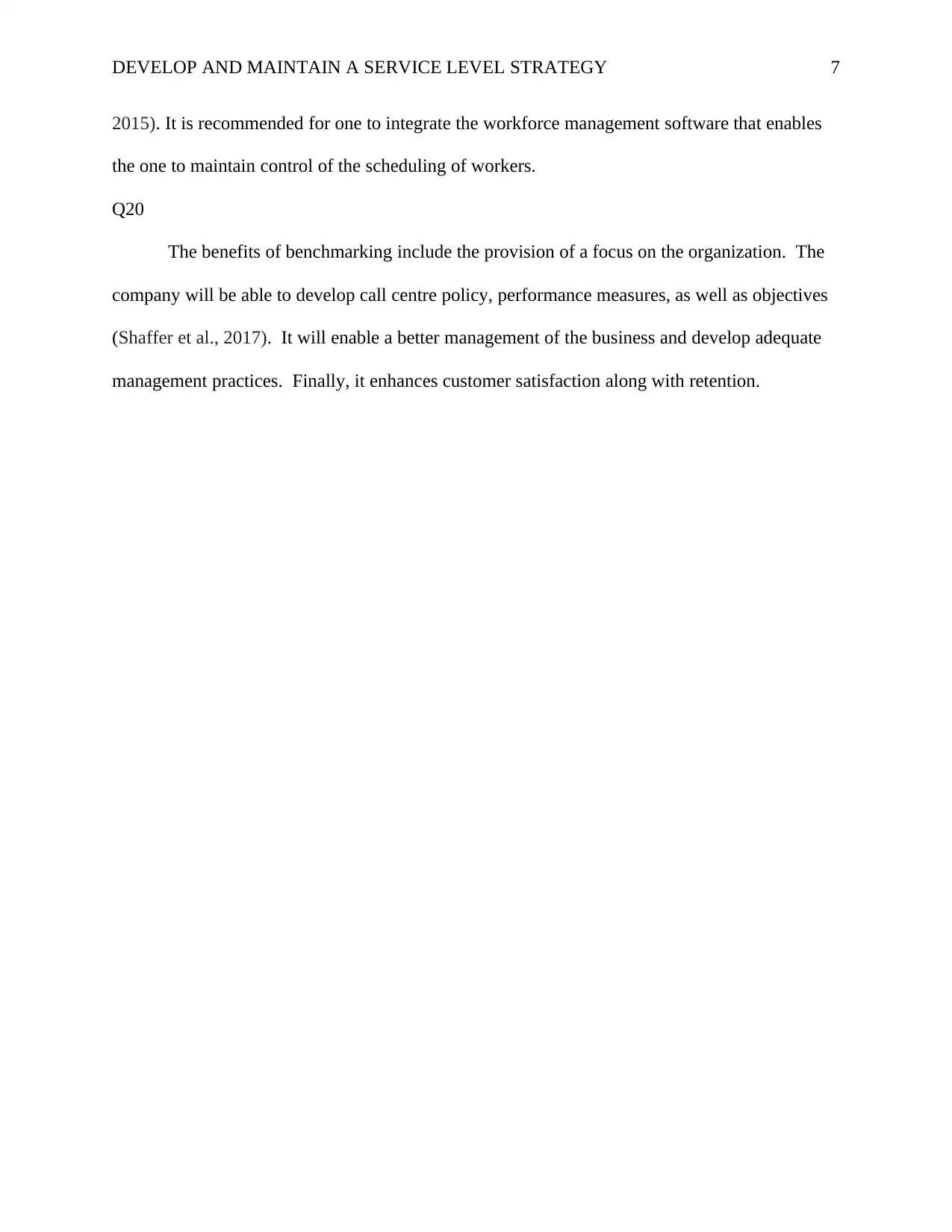
DEVELOP AND MAINTAIN A SERVICE LEVEL STRATEGY 7
2015). It is recommended for one to integrate the workforce management software that enables
the one to maintain control of the scheduling of workers.
Q20
The benefits of benchmarking include the provision of a focus on the organization. The
company will be able to develop call centre policy, performance measures, as well as objectives
(Shaffer et al., 2017). It will enable a better management of the business and develop adequate
management practices. Finally, it enhances customer satisfaction along with retention.
2015). It is recommended for one to integrate the workforce management software that enables
the one to maintain control of the scheduling of workers.
Q20
The benefits of benchmarking include the provision of a focus on the organization. The
company will be able to develop call centre policy, performance measures, as well as objectives
(Shaffer et al., 2017). It will enable a better management of the business and develop adequate
management practices. Finally, it enhances customer satisfaction along with retention.
Paraphrase This Document
Need a fresh take? Get an instant paraphrase of this document with our AI Paraphraser
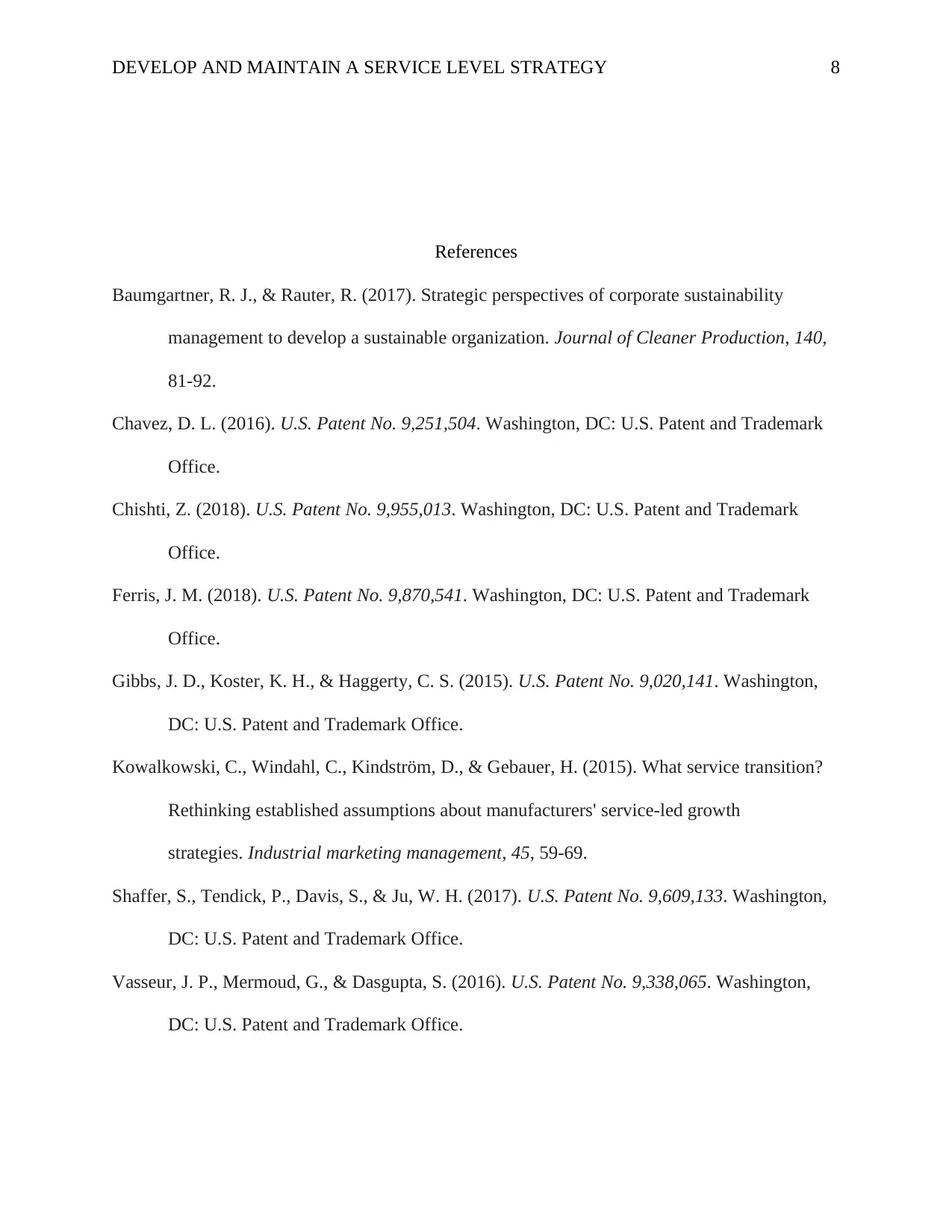
DEVELOP AND MAINTAIN A SERVICE LEVEL STRATEGY 8
References
Baumgartner, R. J., & Rauter, R. (2017). Strategic perspectives of corporate sustainability
management to develop a sustainable organization. Journal of Cleaner Production, 140,
81-92.
Chavez, D. L. (2016). U.S. Patent No. 9,251,504. Washington, DC: U.S. Patent and Trademark
Office.
Chishti, Z. (2018). U.S. Patent No. 9,955,013. Washington, DC: U.S. Patent and Trademark
Office.
Ferris, J. M. (2018). U.S. Patent No. 9,870,541. Washington, DC: U.S. Patent and Trademark
Office.
Gibbs, J. D., Koster, K. H., & Haggerty, C. S. (2015). U.S. Patent No. 9,020,141. Washington,
DC: U.S. Patent and Trademark Office.
Kowalkowski, C., Windahl, C., Kindström, D., & Gebauer, H. (2015). What service transition?
Rethinking established assumptions about manufacturers' service-led growth
strategies. Industrial marketing management, 45, 59-69.
Shaffer, S., Tendick, P., Davis, S., & Ju, W. H. (2017). U.S. Patent No. 9,609,133. Washington,
DC: U.S. Patent and Trademark Office.
Vasseur, J. P., Mermoud, G., & Dasgupta, S. (2016). U.S. Patent No. 9,338,065. Washington,
DC: U.S. Patent and Trademark Office.
References
Baumgartner, R. J., & Rauter, R. (2017). Strategic perspectives of corporate sustainability
management to develop a sustainable organization. Journal of Cleaner Production, 140,
81-92.
Chavez, D. L. (2016). U.S. Patent No. 9,251,504. Washington, DC: U.S. Patent and Trademark
Office.
Chishti, Z. (2018). U.S. Patent No. 9,955,013. Washington, DC: U.S. Patent and Trademark
Office.
Ferris, J. M. (2018). U.S. Patent No. 9,870,541. Washington, DC: U.S. Patent and Trademark
Office.
Gibbs, J. D., Koster, K. H., & Haggerty, C. S. (2015). U.S. Patent No. 9,020,141. Washington,
DC: U.S. Patent and Trademark Office.
Kowalkowski, C., Windahl, C., Kindström, D., & Gebauer, H. (2015). What service transition?
Rethinking established assumptions about manufacturers' service-led growth
strategies. Industrial marketing management, 45, 59-69.
Shaffer, S., Tendick, P., Davis, S., & Ju, W. H. (2017). U.S. Patent No. 9,609,133. Washington,
DC: U.S. Patent and Trademark Office.
Vasseur, J. P., Mermoud, G., & Dasgupta, S. (2016). U.S. Patent No. 9,338,065. Washington,
DC: U.S. Patent and Trademark Office.
1 out of 8
Related Documents
Your All-in-One AI-Powered Toolkit for Academic Success.
+13062052269
info@desklib.com
Available 24*7 on WhatsApp / Email
![[object Object]](/_next/static/media/star-bottom.7253800d.svg)
Unlock your academic potential
Copyright © 2020–2025 A2Z Services. All Rights Reserved. Developed and managed by ZUCOL.




